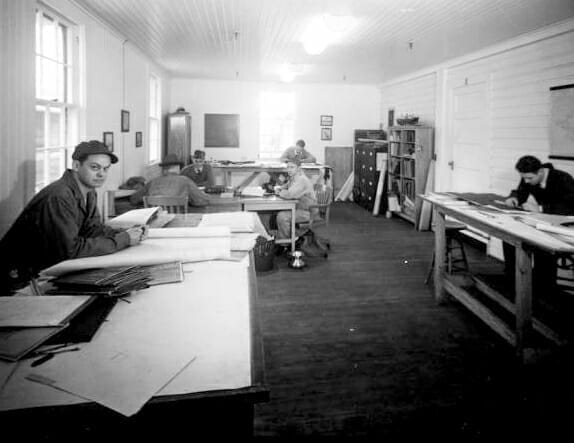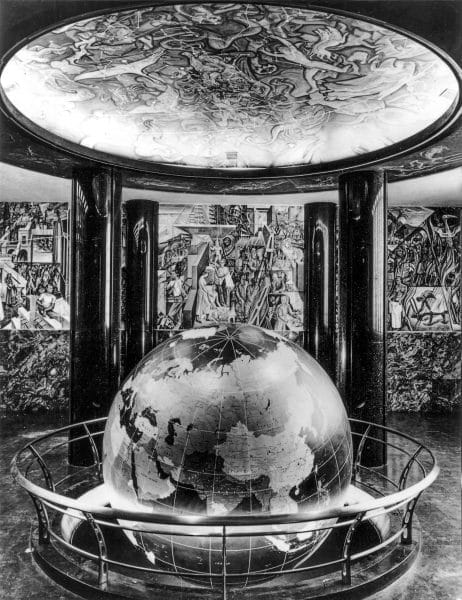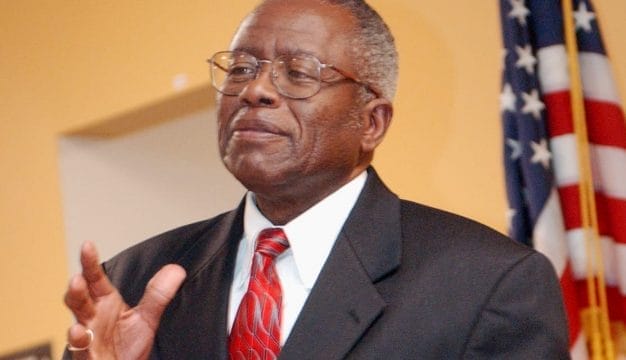Waterman Steamship Corporation
The Waterman Steamship Corporation was established in Mobile in 1919 and grew into one of the nation’s largest shipping companies after World War II. The company brought jobs and federal investment into the city that helped offset the economic stagnation of the Great Depression and transformed Mobile into a shipbuilding town.
 Waterman Steamship Headquarters
America’s entrance into World War I exposed serious problems in Mobile’s port facility and thus prompted the creation of the Waterman Steamship Company. Although the first government shipbuilding contracts were awarded to companies in Mobile in 1917, the city faced a labor shortage, and the majority of its shipbuilding facilities were inadequate. As a result, only one ship launched from the port before the end of the war. Several local entrepreneurs soon became convinced that the city’s future depended on the expansion of its port facilities. John B. Waterman, who was born in New Orleans in 1866, moved to Mobile in 1902 to work for the railroads and led efforts to strengthen Mobile’s port facilities. Waterman joined with local Coca-Cola bottler Walter Bellingrath (who with his wife, Bessie, established Bellingrath Gardens), lumberman C. W. Hempstead, and Mobile lawyer T. M. Stevens to form the Waterman Steamship Corporation in 1919, with $2,000 in capital and one ship, the Eastern Sun, on loan from the United States Shipping Board. The company shipped construction materials and equipment to nearby Florida ports of Tampa and Panama City.
Waterman Steamship Headquarters
America’s entrance into World War I exposed serious problems in Mobile’s port facility and thus prompted the creation of the Waterman Steamship Company. Although the first government shipbuilding contracts were awarded to companies in Mobile in 1917, the city faced a labor shortage, and the majority of its shipbuilding facilities were inadequate. As a result, only one ship launched from the port before the end of the war. Several local entrepreneurs soon became convinced that the city’s future depended on the expansion of its port facilities. John B. Waterman, who was born in New Orleans in 1866, moved to Mobile in 1902 to work for the railroads and led efforts to strengthen Mobile’s port facilities. Waterman joined with local Coca-Cola bottler Walter Bellingrath (who with his wife, Bessie, established Bellingrath Gardens), lumberman C. W. Hempstead, and Mobile lawyer T. M. Stevens to form the Waterman Steamship Corporation in 1919, with $2,000 in capital and one ship, the Eastern Sun, on loan from the United States Shipping Board. The company shipped construction materials and equipment to nearby Florida ports of Tampa and Panama City.
 Waterman Steamship
In the mid-1920s, Waterman began shipping materials to San Juan, Puerto Rico. By 1930, the Waterman fleet had grown to 14 ships. In 1931, John Waterman secured a contract with the U.S. Postal Service to transport mail and initiated an extensive overhaul of his fleet that provided jobs to the failing economy in Depression-era Mobile. John Waterman died in 1937 before the refitting operations were completed. The corporation honored his memory by naming a ship after him in the 1940s.
Waterman Steamship
In the mid-1920s, Waterman began shipping materials to San Juan, Puerto Rico. By 1930, the Waterman fleet had grown to 14 ships. In 1931, John Waterman secured a contract with the U.S. Postal Service to transport mail and initiated an extensive overhaul of his fleet that provided jobs to the failing economy in Depression-era Mobile. John Waterman died in 1937 before the refitting operations were completed. The corporation honored his memory by naming a ship after him in the 1940s.
 Waterman Steamship Employees, 1942
The Waterman Steamship Corporation was an important part of Mobile’s development during World War II. Shipbuilding and shipping were the twin pillars of Mobile’s wartime economy and drew thousands of workers, swelling the city’s population from 79,000 to 125,000. During the war, Waterman employed about 500 men in south Alabama. By 1941, the company operated 125 vessels and employed 900 merchant marines. Although Waterman’s European trade routes were disrupted by German submarines, the Latin American trade routes prospered. During the war, Waterman Steamship Corporation acted as an agent of the War Shipping Administration, which oversaw transport of war-related materials. Its subsidiary, Gulf Shipbuilding Corporation, in nearby Chickasaw, built and repaired scores of ships for the U.S. Navy. The company had other subsidiaries, including its own stevedoring company and repair yards in Tampa, Florida, and Puerto Rico.
Waterman Steamship Employees, 1942
The Waterman Steamship Corporation was an important part of Mobile’s development during World War II. Shipbuilding and shipping were the twin pillars of Mobile’s wartime economy and drew thousands of workers, swelling the city’s population from 79,000 to 125,000. During the war, Waterman employed about 500 men in south Alabama. By 1941, the company operated 125 vessels and employed 900 merchant marines. Although Waterman’s European trade routes were disrupted by German submarines, the Latin American trade routes prospered. During the war, Waterman Steamship Corporation acted as an agent of the War Shipping Administration, which oversaw transport of war-related materials. Its subsidiary, Gulf Shipbuilding Corporation, in nearby Chickasaw, built and repaired scores of ships for the U.S. Navy. The company had other subsidiaries, including its own stevedoring company and repair yards in Tampa, Florida, and Puerto Rico.
By the end of World War II, the Waterman Steamship Corporation had become one of the largest shipping companies in the United States. In 1946, Waterman began planning for new corporate offices in Mobile. That same year, the company established its own short-lived commercial airline service, under the leadership of John Waterman’s son, Carroll. The airline failed to get the required endorsement of the Civil Aeronautics Board, however, and the U.S. Supreme Court ruled that Waterman Airlines be terminated in 1948.
 Waterman Globe
The Waterman Building on Saint Joseph Street was completed in 1948 and was one of the boldest architectural statements that Mobile had entered the Modern era. In May 1950, the Waterman Building opened its doors to the public for inspection. Residents were given access to all 17 floors and marveled at the 16th-story balcony filled with azaleas that overlooked the bay. The two-story lobby displayed three large murals and a 12-foot, rotating globe in the center. There were only two other such globes in the nation at the time. The lobby was so popular that two greeters were employed full time and local schools took field trips regularly to see the rotating globe. There was no greater symbol of post-war confidence than the new Waterman Building and its massive globe.
Waterman Globe
The Waterman Building on Saint Joseph Street was completed in 1948 and was one of the boldest architectural statements that Mobile had entered the Modern era. In May 1950, the Waterman Building opened its doors to the public for inspection. Residents were given access to all 17 floors and marveled at the 16th-story balcony filled with azaleas that overlooked the bay. The two-story lobby displayed three large murals and a 12-foot, rotating globe in the center. There were only two other such globes in the nation at the time. The lobby was so popular that two greeters were employed full time and local schools took field trips regularly to see the rotating globe. There was no greater symbol of post-war confidence than the new Waterman Building and its massive globe.
By the 1950s, the Waterman Steamship Corporation had become the largest privately owned steamship company in the world, operating 140 vessels. The need for new or refitted vessels waned following the end of World War II, and Waterman closed its Chickasaw shipyard in 1952. Three years later, the company was purchased by McLean Securities Corporation for $42 million. McLean would become the leading promoter of containerized shipping. The Waterman Building, renamed for E. A. Roberts, longtime employee and last chairman of the company, was sold to a bank in 1973. After the bank officials moved in to the building, they had the Waterman Globe dismantled and put into storage.
In 1978, the University of South Alabama secured the globe and transferred it to its campus in West Mobile. After years of delay and painstaking reconstruction, the restored Waterman Globe was unveiled at a Mobile Chamber of Commerce meeting in January 1996 and is now permanently displayed in the lobby of the Mitchell Center, the university’s basketball arena. In 1989, the small remaining Waterman office in Mobile was moved to New Orleans. The Waterman Globe and the Roberts Building on St. Joseph Street remain as visual reminders of one of Mobile’s largest companies and the commitment of its founder to Alabama’s Port City. In 2017, SEACOR Holdings purchased Waterman, which continues to operate ocean transport vessels as its Roll On/Roll Off fleet and maintains an office in Mobile.
Further Reading
- Cronenberg, Allen. Forth to the Mighty Conflict: Alabama and World War II. Tuscaloosa: University of Alabama Press, 1995.
- John B. Waterman Papers, The Doy Leale McCall Rare Book and Manuscript Library, Mobile, Alabama.
- Olliff, Martin, ed. The Great War in the Heart of Dixie: Alabama in World War I. Tuscaloosa: University of Alabama Press, 2008.



